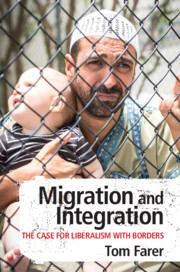Book contents
- Reviews
- Migration and Integration
- Migration and Integration
- Copyright page
- Dedication
- Epigraph
- Contents
- Figures
- Acknowledgments
- Introduction
- Part I Entry and Integration
- 1 The Looming Wave
- 2 Sovereignty, Nationalism, and Human Rights
- 3 Integration and Cultural Difference
- Part II Exemplary National Experiences
- Part III Hard Choices
- Notes
- Bibliography
- Index
1 - The Looming Wave
from Part I - Entry and Integration
Published online by Cambridge University Press: 15 November 2019
- Reviews
- Migration and Integration
- Migration and Integration
- Copyright page
- Dedication
- Epigraph
- Contents
- Figures
- Acknowledgments
- Introduction
- Part I Entry and Integration
- 1 The Looming Wave
- 2 Sovereignty, Nationalism, and Human Rights
- 3 Integration and Cultural Difference
- Part II Exemplary National Experiences
- Part III Hard Choices
- Notes
- Bibliography
- Index
Summary
The author discusses both the push factors promising intensifying pressure on the borders of Europe (and ultimately, perhaps, the United States) and the problematic condition of the European economy marked in some important countries by high unemployment, particularly among youth; stagnant middle- and working-class incomes; and, in the United Kingdom, for example, growing strains on the welfare state. He uses demographic, employment, and income data to expose the extraordinary increase in population projected for areas (Africa, Middle East, West Asia) marked by dysfunctional government, grossly insufficient employment opportunities, and the combination of deep poverty yet increasing means to afford clandestine passage to Europe. An increase of one billion people is projected for 2050. State breakdown, internal violence, environmental deterioration, and natural disasters will drive people across borders. The author then explains the gap between Western governments’ promises to reduce migration and their failure to fulfill them. The pro-migration coalition brings together corporate interests, liberals, civil rights and civil liberties constituencies and organizations, and political leaders representing earlier generations of migrants from the Global South. The very nature of the liberal state makes borders porous and forced repatriation difficult.
- Type
- Chapter
- Information
- Migration and IntegrationThe Case for Liberalism with Borders, pp. 17 - 26Publisher: Cambridge University PressPrint publication year: 2019

